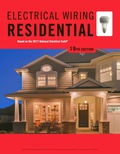
EBK ELECTRICAL WIRING RESIDENTIAL
19th Edition
ISBN: 9781337516549
Author: Simmons
Publisher: CENGAGE LEARNING - CONSIGNMENT
expand_more
expand_more
format_list_bulleted
Concept explainers
Question
Chapter 5, Problem 5R
To determine
Mention different types of lighting switches.
Expert Solution & Answer
Trending nowThis is a popular solution!

Students have asked these similar questions
A single phase has two group A and B, 50 Hz, overhead line system has radius of conductor 0.5 cm.
Calculate the total inductance of the line
21
A
a2
b₂
4 m
B
b₁
3m
6 cm
2 m
In a single phase below, conductors a₁ and a₂ are in parallel form one circuit while conductors b₁
and b₂ in parallel form the return path. Calculate the total inductance of the line per km assuming that
current is equally shared by the two parallel conductors. Conductor diameter in 2-0 cm.
a₁
az
b₁
b₂
100 cm
20 cm
20 cm
Don't use ai to answer I will report you answer
Chapter 5 Solutions
EBK ELECTRICAL WIRING RESIDENTIAL
Ch. 5 - The identified grounded circuit conductor must be...Ch. 5 - Explain how lighting switches are rated.Ch. 5 - Prob. 4RCh. 5 - Prob. 5RCh. 5 - To control a lighting load from one control point,...Ch. 5 - Prob. 7RCh. 5 - Complete the connections in the following...Ch. 5 - Complete the connections for the diagram....Ch. 5 - A three-way switch may be compared to a _____...Ch. 5 - Prob. 11R
Ch. 5 - Complete the connections in the following...Ch. 5 - When connecting 4-way switches, care must be taken...Ch. 5 - Show the connections for a ceiling outlet that is...Ch. 5 - Match the following switch types with the correct...Ch. 5 - When connecting single-pole, 3-way, and 4-way...Ch. 5 - What section of the Code emphasizes the fact that...Ch. 5 - If you had to install an underground 3-wire feeder...Ch. 5 - Is it always necessary to attach the bare...Ch. 5 - List the methods by which an equipment grounding...Ch. 5 - When two nonmetallic-sheathed cables (Type NM-B)...Ch. 5 - Define an equipment grounding conductor.Ch. 5 - When metal toggle switchplates are used with...Ch. 5 - Does the Code permit the ampacity of switch legs...Ch. 5 - Prob. 26RCh. 5 - Prob. 27R
Knowledge Booster
Learn more about
Need a deep-dive on the concept behind this application? Look no further. Learn more about this topic, electrical-engineering and related others by exploring similar questions and additional content below.Similar questions
- Don't use ai to answer I will report you answerarrow_forward4. Discussion: GINEE Compare between theoretical combination effect of Kp and KD at first order and second order systems regarding steady-state errors and transient responses with the practical obtained results whenever applying step input signalın Experiment PD controller و المهندسة الكهربائيةarrow_forwardDon't use ai to answer I will report you answerarrow_forward
- Don't use ai to answer I will report you answerarrow_forwardPlot the magnitude spectrum analytically predict by the equation below: n=∞ s(t) = Σ In (ß) cos[2π(fc +nfm)t] n=-∞ fc = 1MHz fm = 10 kHz B = 5arrow_forwardb C Is 3601116-67 Bre ✓ BIb ≤5K 20k e 0-25K 7. Zo Z Zb B=100, Ble=1Kr Zb=S & Zin = S, Zo=S, AV=Sarrow_forward
- Don't use ai to answer I will report you answerarrow_forward4. Discussion: GINEE Compare between theoretical combination effect of Kp and KD at first order and second order systems regarding steady-state errors and transient responses with the practical obtained results whenever applying step input signalın Experiment PI controller و الهندسة الكهربائيةarrow_forwardهمسة 4. Discussion: Compare between theoretical combination effect of Kp, KI and KD at second order systems regarding steady-state errors and transient responses with the practical obtained results whenever applying step input signalln Experiment PID Controllerarrow_forward
arrow_back_ios
SEE MORE QUESTIONS
arrow_forward_ios
Recommended textbooks for you
 EBK ELECTRICAL WIRING RESIDENTIALElectrical EngineeringISBN:9781337516549Author:SimmonsPublisher:CENGAGE LEARNING - CONSIGNMENT
EBK ELECTRICAL WIRING RESIDENTIALElectrical EngineeringISBN:9781337516549Author:SimmonsPublisher:CENGAGE LEARNING - CONSIGNMENT

EBK ELECTRICAL WIRING RESIDENTIAL
Electrical Engineering
ISBN:9781337516549
Author:Simmons
Publisher:CENGAGE LEARNING - CONSIGNMENT